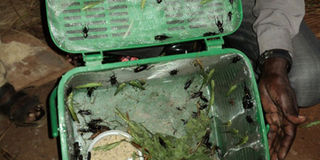Tapping into the wealth potential of insects

Insects like grasshoppers and crickets are rich source for nutrients to supplement diet and present an opportunity for business. photo by Faiswal Kasirye
The experts have finally “discovered” what our forefathers knew all along; that eating insects is healthy. According to a report compiled by the UN Food and Agriculture Organisation (FAO), edible insects can help fight hunger, boost nutrition and reduce pollution.
It describes grasshoppers, ants and other members of the insect family as an underutilised food resource for people and livestock.
Back in the day, educated Africans were expected to abandon the “primitive” culture of munching white ants (nswa) and grasshoppers (mayanzi/nsenene) now that they had become “civilised”. Unknown to the “civilising” agents, these insects provided free animal protein for poor Africans who could not afford meat or fish.
After a heavy starch-loaded meal, the children would dash off to the garden to hunt for Cicada (nyanyagize) and other crawling and flying insects, to enjoy as raw or roasted dessert. Not even the likelihood of encountering a venomous snake, on a similar mission, would deter them. No wonder, cases of malnutrition were few.
Thanks to technological innovations such as the use of electrical lights to beacon insects like grasshoppers and white ants, we do not have to compete with snakes for the winged delicacies.
Highly nutritious
The FAO study states two billion people worldwide already supplement their diets with insects, which are high in protein and minerals, and have environmental benefits. Insects, food nutritionists have established, can provide the body with essential minerals such as copper, iron, magnesium, manganese, phosphorus, selenium and zinc, and are also a source of fibre.
Entomologists (insect experts) say insects are extremely efficient in converting feed into edible meat. On average, they can convert two kilogrammes of feed into a kilogramme of meat. In comparison, cattle require eight kilogrammes of feed to produce 1kg of meat.
Generally, insects produce fewer green house gases. Some of them feed on human and food waste, compost and animal slurry, with the products being used for agricultural feed.
Insects reproduce quickly, provide high-quality protein and nutrients when compared with meat and fish. There are particularly important as a food supplement for undernourished children.
Insects are business
A number of shopping arcades in downtown Kampala, are owned by traders who got their seed money from trapping nsenene in Nyendo town in Masaka in the 80s and 90s.
The traders would rig up powerful florescent lights at night, next to which they would place a funnel shaped slippery iron sheet to trap and direct the dazzled insects into a metallic drum on the ground.
The trapped insects would be packed in gunny bags, loaded into car boots, left open to allow aeration and driven to Nakasero and other urban markets in different parts of the country. As the demand for nsenene grew, Nyendo town lost the title of Uganda’s nsenene capital as new trapping grounds sprouted in Wakaliga and Kamwokya city suburbs.
Thanks to the research efforts of food scientists at Makerere University, the highly perishable and seasonal insects can now be enjoyed year round, and are also being exported for Ugandans living in the diaspora to enjoy.
Contributing their bit to the development of the budding nsenene industry, insect scientists (entomologists) in different research institutions are trying to find ways of rearing the wild insects in a domestic setting. If they succeed, nsenene farming will be yet another money-making enterprise for farmers to engage in.
With the increased availability, and growing popularity, the local catering industry has started including nsenene on the list of indigenous snacks on offer.
Like nsenene, white ants are a popular delicacy in different parts of the country. There is a lot of literature on the art and craft of trapping, processing and preparing white ants into different delicious dishes. Unfortunately, the white ant population is facing a very big threat from people who should know better – farmers. There is a silent but destructive war going on, with the farmers deploying chemical weapons to destroy the “enemy”.
Discover wealth
Accusing the ants of destroying their maize and other crops, the farmers use a combination of chemical and mechanical means to systematically destroy the ant hills on their farms. Ironically, the same farmers spend part of their earnings from maize, to buy white ants from the market.
Entomologists can save the situation by educating farmers about the important contribution white ants and other insects make to boost their farm yields.
If only farmers knew that the iron-rich red anthill soil is good for new born piglets and lactating sows, if only they knew the role ants play in enriching the soils, if only they could stop and ask themselves why certain medicinal mushrooms only grow around anthills, they would perhaps spare those anthills.
Insects are wealth. We need to discover and tap into that wealth.
The author is a farming journalist
and a consultant .
E-mail: [email protected]




